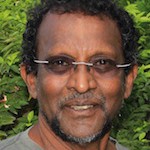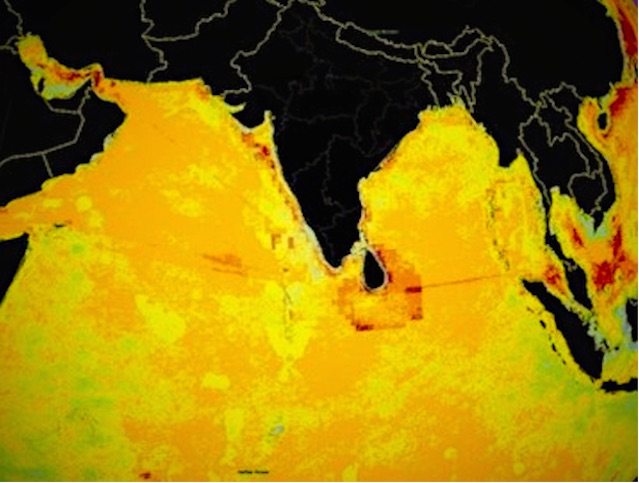The Tightening Noose

By Ranil Senanayake –April 17, 2017
It is said that a picture is worth a thousand words. The image below produced by Google mapping marine pollution says many things. First, that much like India our coastal zones are affected by land based pollution. The thin red line that wraps around the island suggests that our near ocean waters have been seriously polluted by effluent from the land. But unlike India or any other neighboring country, there is yet another ring of oceanic pollution extending one hundred or more nautical miles into the Indian ocean. Like a noose around the inland with the ropes going east and west we are in the middle. In both our territorial waters and our extended economic zone, our waters are being polluted and poisoned by international shipping and we are proud that we have a unique position in the Indian Ocean vis-à-vis shipping. We want to increase our exposure to shipping, but do nothing to protect ourselves from the consequences.
Shipping is the most polluting of all transport. Because of decisions taken by the International Maritime Organization (IMO) based in London, which frames maritime policy, it is legal for ships to burn a substance called ‘Bunker Fuel’, which is the thick residue left behind in refineries after the lighter liquids have been taken off. It is stuff nobody on land is allowed to use because of its huge pollution potential. It is the cheapest, filthiest, high-sulphur fuel yet the IMO rules allow ships to burn fuel containing up to 4.5 per cent sulphur. This is 4,500 times more than is allowed in car fuel in the European Union. To make things worse, the tiny particulate sulphur comes that comes out of ship funnels are the very type that that get deep into lungs of humans and animals. The levels ultrafine particulates or PM 2.5’s (a subgroup of particulate matter), which are especially harmful for human health, are up to 100 times above the normal load, in ship exhaust gases.
The Blue Whales of Sri Lanka are a national treasure and famous tourist attraction; they live just at the edge of the continental shelf south of the Island. However the vast traffic of international shipping also sees this zone as easy passage. With the plans for shipping increase to Hambantota, the atmospheric concentration of these particulates will increase dramatically in this zone. Whales are mammals like us and have huge lungs into which they suck the air polluted by shipping. Whale conservationists should look into the sustainability of populations living in high shipping zones.
Shipping terminals are especially bad. Compared to what has to be considered as “clean air“ where 1,000 particles per cubic centimeter is considered ‘safe’, scientists have found up to 400,000 (ppm/cm2) next to shipping terminals. In these situations, the particle numbers exceeded the concentration level by more than a factor 400. Such air pollution levels surpass concentrations next to main roads with dense traffic by 50 to 80 times. As ports are often located in city centers or close by cities, their air pollution endangers many people’s health. Particulate matter causes and worsens coronary and pulmonary diseases. Has Colombo addressed this threat to its citizens ?
Pollution by ocean shipping is so bad that just 16 of the world’s largest ships can produce as much lung-clogging sulphur pollution in a day as all the world’s cars. The IMO’s rules means that that the largest ships can each emit as much as 5,000 tons of sulphur in a year into the atmosphere, this is equivalent to 50 million typical cars, each emitting an average of 100 grams of sulphur a year.


